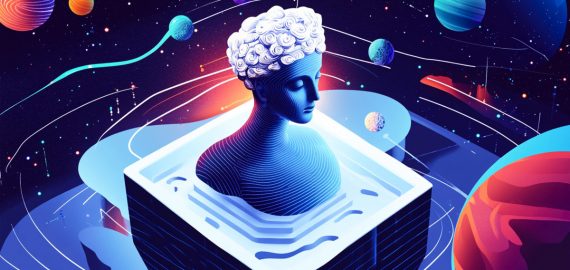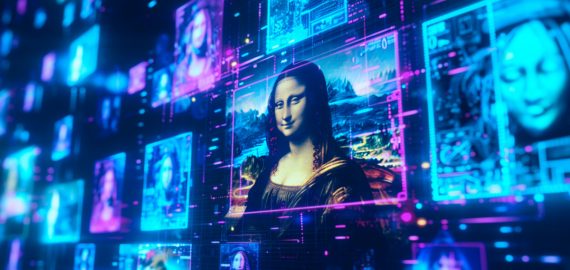NFT Art: What it is, how NFTs work, and what it all means and stands for



When discussing NFT art and what it can mean for the world of art, let’s first go back in time. In 1874, the Paris photography studio of Félix Nadar presented paintings rejected by the traditional art world. It posed as the alternative to the Salon de Paris, the official exhibition of Académie des Beaux-Arts.
That’s where ground-breaking painters like Edgar Degas, Auguste Renoir, and the man who started it all—Claude Monet—presented their revolutionary paintings. They would become household names for a new art movement—impressionism—and would mark the end of an era in the history of art and the birth of modern art.

Now, as NFT art is gaining prominence, we may just be watching something just as revolutionary in art history.
Table of contents
- So, what is NFT art?
- What can be turned into an NFT?
- What does it mean for creators?
- What does NFT stand for?
- Are NFTs scams? Will it die out?
- Are NFTs bad for the environment?
- What is the technology behind NFTs?
- Why are NFTs the future?
- How do artists price NFTs?
- Notable NFT Projects
- Frequently asked questions
- When first NFT was created?
- Can NFT be a photo?
- Are NFTs illegal?
- Are NFTs taxed?
- Can NFTs be stolen or copied?
- Can NFT metadata be changed?
- Why do NFTs have value?
- Can NFTs lose value?
- Why is NFT art bad?
- Why are NFTs good?
- Why will NFTs fail?
- Where are NFTs stored?
- Will NFTs die, crash, or bubble burst?
- Why are NFTs stupid?
- What is an NFT gas fee?
- Can films and MP4 be NFT?
So, what is NFT art?
In simplest terms, digital art has been put on a blockchain. Until now, artists had one issue with digital art—it could be endlessly copied, replicated, and reprinted. In the world of digital media, there are no originals, only copies. However, NFTs can offer a difference in the world of art. When you put a piece of art on a blockchain, it becomes one of a kind. There is an original which the artist can own and sell online.
Just like a sculpture or a painting, digital art can now be unique. It has become nonfungible—while a jpg file can be copied, the same cannot be said about an NFT. Just like only one Claude Monet’s “Impression, Sunrise” inspired the impressionist movement, there can be only one token.
What can be turned into an NFT?
Any medium can be minted and become an NFT. A photograph, a digital painting, a video, an audio clip. Indeed, the sky—and the imagination—is the limit.
This means artists can experiment with new media and formats or use mixed media for their art projects. The medium is less limiting than traditional art, and digital art offers new depths of freedom of expression. Digital art is often experimentative and novel, exploring the possibilities of new media.
What does it mean for creators?
NFTs have a chance to bring artists closer to the audience and give them the opportunity to buy their art. It’s also a relatively inclusive form of art; artists can use free software to create their pieces and put them on a blockchain free of charge. Unlike traditional art media that require investment upfront, artists can benefit and make a living from their creations without spending a fortune beforehand.
They can also do so without an intermediary. They don’t have to turn to action houses and appease art galleries. Instead, they can turn to crypto communities and their fans and reach out to them directly.
What does NFT stand for?
Non-fungible token, though this doesn’t clear up much, I guess.
Let’s tackle fungibility first. Cryptocurrencies and fiat currencies are fungible. In simple terms, when you have a bitcoin, you can exchange it for another. Two bitcoins have the same value; when making a transaction, it doesn’t matter which one you use.
“Non-fungible,” on the other hand, means unique. One NFT cannot be replaced with any other. Just like there is only one Mona Lisa, there’s only one CryptoPunk #8531. Each NFT is different and cannot be exchanged for one another. Even NFTs from the same collection can have completely different monetary values.
Take a look at CryptoPunks, for instance: While the seven-day average price of the CryptoPunks is just $74.2k, CryptoPunk #8531 sold last month for an astounding $905.7k.
Are NFTs scams? Will it die out?
NFTs are a form of digital asset, and there’s nothing insidious or scammy about them, per se. However, just like everywhere in life, you can find bad agents.
Scammers are everywhere, and the internet is full of them—and unfortunately, the NFT scene is also not unaffected by them. There are ways to protect yourself from scammers, the most essential being: always check the links you’re clicking and don’t provide anyone with your wallet and password information. It usually is when you see an offer too good to be true, such as an unannounced airdrop of a famous NFT. Stay vigilant.
NFTs are still relatively new, so it’s impossible to say what the future will bring for them. While they are likely to change and gain more uses, they are unlikely to disappear completely. NFTs are gaining more utility; they can be used as tickets, and legal documents, and serve as proof of ownership.
Are NFTs bad for the environment?
NFTs are not inherently bad for the environment; however, their production, otherwise referred to as minting, can take up a lot of electric energy and thus produce a lot of CO2 and contribute to the greenhouse effect. However, it doesn’t have to be the case.
Depending on personal preferences and your budget, you can minimize, or even completely dissipate, your carbon footprint. The environmental impact can be mitigated by choosing low-emission blockchains when minting your NFT like Polkadot or Cardano. There are even zero-emissions solutions like the carbon-neutral Solana blockchain. Ethereum, the most popular blockchain, is also working towards becoming more sustainable—the new version of the blockchain, Ethereum 2.0, will use 99.95% less energy than it does now.
What is the technology behind NFTs?
Blockchain. Simply put, a blockchain is a shared database accessible to people online. It’s distributed among s lot of people, is difficult to alter, and so much more complex than ordinary databases to hack.
Why are NFTs the future?
NFTs have widespread uses that we’ve only begun discovering. While they started as collectables and art pieces, there is a lot more to NFTs, and that’s why they’re here to stay. Of course, that’s not to say that the NFT art is dying out—fascinating projects are being launched every day. However, NFTs have also reached online gaming, fashion,
NFTs can be used as tickets: Qatar Airways plans to add NFT tickets as an option, while Olympics organizers are considering NFT tickets for the Paris Olympics 2024. In addition, the UK has approved serving legal documents via NFTs, so people can now file suits via the blockchain.
How do artists price NFTs?
It’s entirely up to the artist. There is no one-answer-fits-all. When pricing your NFT, you must calculate the transaction costs and possible gas fees so that you don’t end up in the negative. However, it’s up to the artist whether they want to make $10 on their newest NFT or $1,000. If you think your project will sell, you can set a high price; if you’re a developing artist, it might be a good idea to keep the price accessible and promote your project to gain recognition and earn more on future projects.
Notable NFT Projects
Let’s have a look at some of the more recognizable NFT projects.
Bored Ape Yacht Club (BYAC)
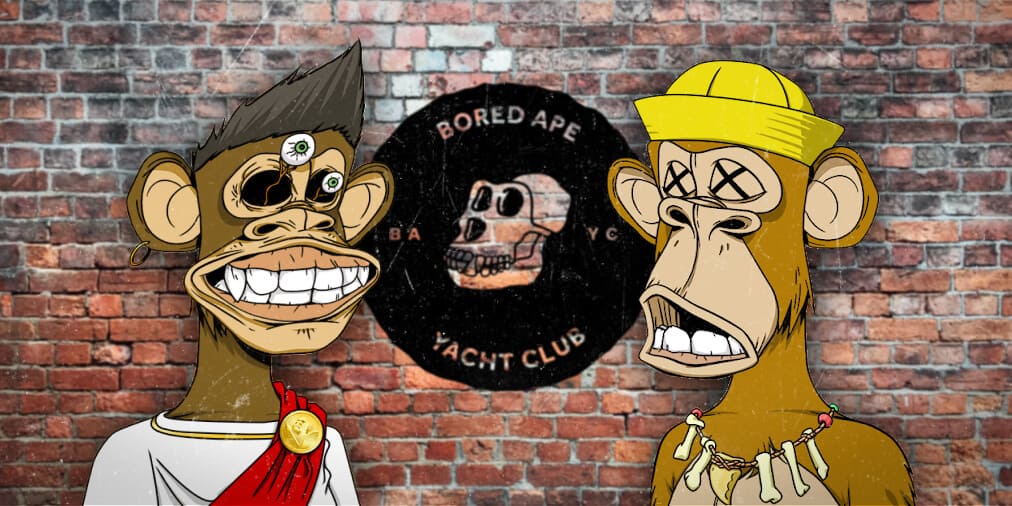
BYAC is one of the most well-known collections of generative art created by Yuga Labs. The collection consists of 10,000 unique Bored Ape NFTs and was minted on the Ethereum blockchain. The NFTs are more than just art, though, as the tokens also serve the role of the Yacht Club membership card. Holders have access to members-only benefits. Following its success, Yuga Labs has launched other successful projects, such as the BYAC spin-off collection Mutant Apes and Kennel Dogs.
Some famous folk have got their hands on the Bored Apes, including Snoop Dogg, Eminem, Madonna, and Paris Hilton. In fact, Snoop Dogg and Eminem have collaborated with BYAC, creating a BYAC-inspired music video for their 2022 single “From The D 2 The LBC.”
CryptoPunks

CryptoPunks is another generative art collection that has risen to notoriety. Like BYAC, it contains 10,000 uniquely generated characters. This creation of Larva Labs, now also owned by Yuga Labs, was sold quickly, and some of the designs have been since sold for astounding prices, with the top-grossing token selling for $23.7 million.
Moonbirds
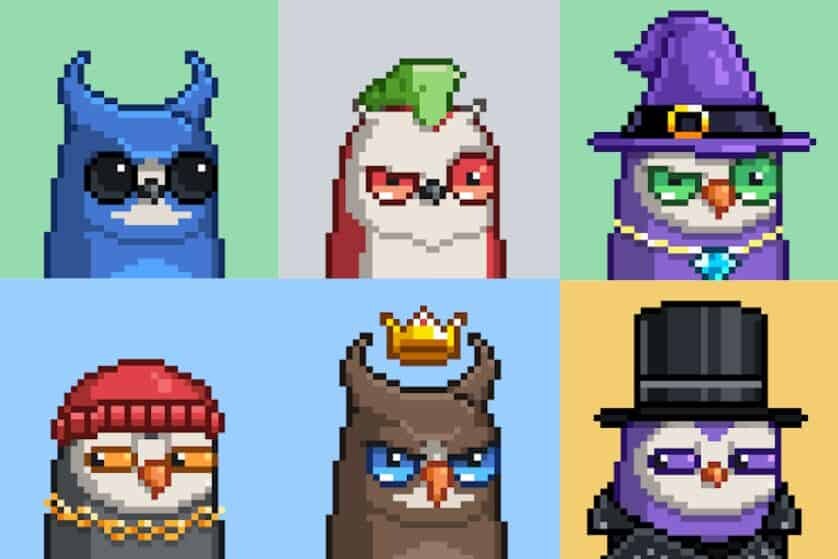
Moonbirds have become another internet sensation when they launched earlier this year. The project consists of 10,000 NFTs. Just a few days after the launch, the tokens already reached 100,000 ETH (approximately $300 million at the time) in secondary sales. Creators also launched an accompanying NFT collection– Moonbirds Oddities collection that was available for its NFT holders.
Top-grossing projects
However, there is more to NFTs than just generative art projects. Let’s have a look at the most famous, and top grossing, art projects. The three top sellers of all time are two art pieces by Pak and one by Beeple. These two artists are probably the best known in the NFT sphere for their distinct styles and personalities.
A generative piece that was shaped by its sales—as holders bought their share of the art project, its final look was decided. The artwork presents three white masses on a black background. The more collectors made the purchase, the larger the masses would become. To this day, it remains the most expensive NFT that has been sold.
A completely different piece—a collage of 5,000 pieces created by Beeple over the years.
A political piece that is a real-time counter that says how long the creator of WikiLeaks, Julian Assange, has been imprisoned. It has been created to help raise funds for Assange’s legal defense in his trial. If you’d like to learn more about the top 10 most expensive NFTs sold up to date, you can check them out here.
Frequently asked questions
When first NFT was created?
The idea for NFTs was first presented in a 2012 paper, in which Meni Rosenfield introduced the idea of “Colored Coins,” but it took a couple of years for the idea to become reality. The first NFT was created in 2014. Artists Kevin McCoy and Anil Dash created the NFT “Quantum” and minted it on the Namecoin blockchain.
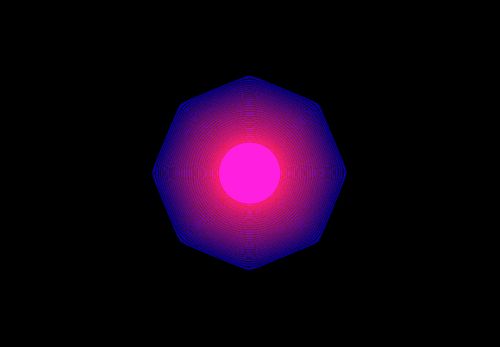
“In 2014, I had an idea to use blockchain technology to create indelible provenance and ownership of digital images of this kind. Quantum was the first ever to be recorded in this way,” wrote Kevin McCoy on his website.
“Quantum” was auctioned off for $1.4 million at a Sotheby’s auction in June 2021.
Can NFT be a photo?

Short answer: Yes.
Long answer: Any type of medium can be minted and become an NFT. That means a photograph, a digital painting, or a video. An NFT doesn’t have to be visual art; it can be an audio clip, a piece of poetry, or clothing. It can be a collage of a photograph and a haiku, like the creation of Sacha Dean Bïyan and Dr Shunkichi Baba. Truly, the sky, and the imagination, is the limit.
This means artists can experiment with new media, new formats, or use mixed media for their art projects. The medium is less limiting than traditional art, and digital art offers new depths of freedom of expression. Digital art is often experimentative and novel, exploring the possibilities of new media.
Are NFTs illegal?
NFTs remain largely unregulated in most countries, meaning there aren’t any or sufficient laws governing NFTs. As of now, the US institutions are exploring ways to keep an eye out on NFTs, there are little-to-no regulations governing NFTs in the UK, while the European Parliament has recently “reached a provisional agreement” regarding crypto assets.
There have been cases where NFTs were deemed illegal. According to the U.S. Department of the Treasury, a Latvian NFT marketplace called Chatex may have been used for laundering the proceeds from ransomware. The SEC has also taken certain assets under scrutiny. A Latvian artist Shvembldr, who made millions in NFT sales, was charged with money laundering through an elaborate illegal scheme.” However, all these cases are just examples of potentially committed crimes.
What about NFT bans? In China, where cryptocurrencies have been delegalized, it is not legal to resell NFTs. This means that while you can make and sell your NFT as a collectible, it is not legal to make secondary sales of the NFT.
Are NFTs taxed?
While it might depend on the country, in general, you need to pay taxes on the profits you make from NFT sales. It’s good to check your country’s regulations regarding such income.
Can NFTs be stolen or copied?
Unfortunately, like any other asset, NFTs can be stolen. The thefts usually involve hacks, scams, or—unfortunately—user error. If a user loses access to their crypto wallet or shares their login details with someone else, they may lose their assets. In general, be careful with your wallet information, just like you should be cautious with your banking details.
When it comes to copying NFTs, you can copy the digital file, but not the NFT itself. The NFT serves as proof of ownership of a digital asset, and so it cannot be copied.
Can NFT metadata be changed?
Yes, but it’s a time-consuming and lengthy process. You can alter the token’s function or its design. You cannot change all the metadata, for instance, you cannot change the token ID and contact address.
Why do NFTs have value?
Why does any art have value? Because the buyer and the seller (as well as the entire community) believe it has value. This is the case of any art piece, collectible, or anything without intrinsic value—they gain value simply because others believe they are valuable. The same goes for NFTs.
Can NFTs lose value?
Yes. Just like NFTs can gain value, they can also lose it.
Why is NFT art bad?
This is purely a matter of preference. While not everyone might enjoy the generative art of BYAC or CryptoPunks, there are so many NFT art styles everyone should be able to find something they find interesting or beautiful.
Why are NFTs good?
NFTs offer proof of ownership over a digital or physical asset. They allow people to financially support artists they admire. Anyone can become an art collector, giving everyone much easier access to art. Of course, if you get an NFT, you also get the rights to use it and, should you want to, sell it for profit, with an artist still making a profit from secondary sales.
Why will NFTs fail?
Many NFT projects don’t gain the prominence the artist, or a brand hopes they will. This may be due to insufficient funding, no plans for advertising, or treating NFTs like a cash grab. While it is possible to make big bucks on an NFT, it’s not a no-fail, fool-proof plan. An artist needs to put a lot of work into advertising and looking for buyers—just like they would in the case of traditional art.
Where are NFTs stored?
NFTs are stored on a blockchain. There are many blockchains that artists can choose from, some of them are more carbon-heavy, while others can be eco-friendly or even zero carbon.
Will NFTs die, crash, or bubble burst?
It is difficult to say what the future holds for NFTs, but it is unlikely they will die out completely. It is much more likely we will discover new use cases for them. NFTs have already started becoming new
Why are NFTs stupid?
NFTs can become extremely expensive due to their scarcity—however, this scarcity is a completely made-up thing. They’re scarce because they are unique and pretty much because we say they are—you can simply copy-paste an image. We are also commodifying culture, for instance, by making viral YouTube videos like “Charlie Bit My Finger” or “Leave Britney Alone” into NFTs.
However, one could argue this also gives the creators the sense o their own agency back–Cara Cunningham faced huge backlash for her video. One could argue that minting the NFT and selling it gave her a sense of agency. Cunningham made 18.6942 ETH, of the sale, which is approximately $44,477.61.
What is an NFT gas fee?
Gas fees are the cost of putting the NFT on the blockchain. Depending on the marketplace, blockchain, and even the time of day, it may differ. There are some blockchains that allow minting NFTs for free, but that usually means the cost of creating an NFT is pushed onto the buyer.
Can films and MP4 be NFT?
Yes, any sort of media file can be minted as an NFT.
Keep track of cryptocurrency distributions in our Airdrops Calendar.
Related articles:
Disclaimer
In line with the Trust Project guidelines, please note that the information provided on this page is not intended to be and should not be interpreted as legal, tax, investment, financial, or any other form of advice. It is important to only invest what you can afford to lose and to seek independent financial advice if you have any doubts. For further information, we suggest referring to the terms and conditions as well as the help and support pages provided by the issuer or advertiser. MetaversePost is committed to accurate, unbiased reporting, but market conditions are subject to change without notice.
About The Author
Karolina is a writer and journalist with a background in literary studies. She loves exciting tech solutions and art, and NFTs are often a perfect amalgamation of the two. Outside of work, she’s a plant mom, a vintage fashion enthusiast, and a gamer.
More articles

Karolina is a writer and journalist with a background in literary studies. She loves exciting tech solutions and art, and NFTs are often a perfect amalgamation of the two. Outside of work, she’s a plant mom, a vintage fashion enthusiast, and a gamer.














































